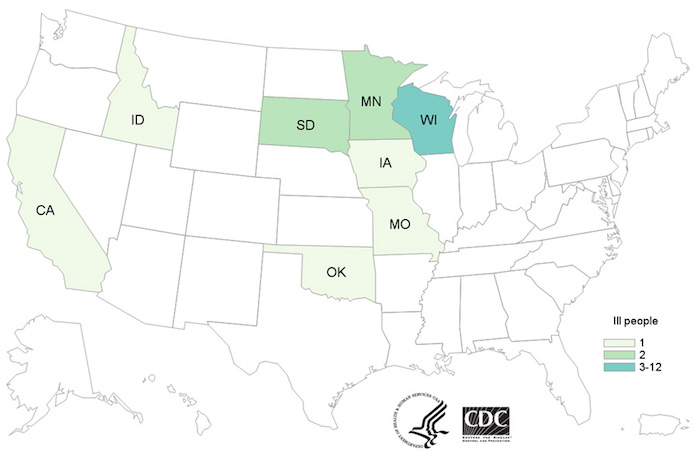The Centers for Disease Control and Prevention (CDC) has released information about a multistate outbreak of multi-drug resistant Salmonella Heidelberg infections linked to contact with dairy bull calves. As of November 28, 2016, 21 people in 8 states are sick.
The case count by state is: California (1), Iowa (1), Idaho (1), Minnesota (2), Missouri (1), Oklahoma (1), South Dakota (2), and Wisconsin (12).
Eight of those sickened were hospitalized. No deaths were reported. Epidemiologic, traceback, and laboratory findings linked this outbreak to contact with dairy bull calves purchased from livestock markets in Wisconsin. These animals are young, male cattle that may be raised for meat and are used in 4H projects.
All of the patient isolates in this outbreak were multidrug resistant. This factor is associated with increased risk of hospitalization, development of a bloodstream infection, or treatment failure. The hospitalization rate for this outbreak is almost twice as high as usual for Salmonella infections.
Public health officials used the PulseNet system to find people who may have been part of this outbreak. Among 19 people who were interviewed, 15 reported contact with dairy bull calves or other cattle. Some of those patients said that they got sick after their dairy bull calves became ill or died.
Illness onset dates were from January 11, 2016 to October 24, 2016. The patient age range is from less than 1 year to 72, with a median age of 21. Sixty-two percent of the patients are female. Whole genome sequencing shows that isolates from the ill people are genetically closely related to each other. That means that people in this outbreak are likely to share a common source of infection.
One patient’s dairy calves were tested for Salmonella. Officials found Salmonella Heidelberg in the calves. Whole genome sequencing showed that isolates from ill people are closely related to isolates from these calves.
Antibiotic resistant testing used by CDC’s NARMS laboratory on clinical isolates from two people in this outbreak showed they were susceptible to gentamicin,azithromycin, and meropenem. Both of the isolates were resistant to amoxicillin-clavulanic acid, ampicillin, cefoxitin, ceftriaxone, chloramphenicol, nalidixic acid, streptomycin, sulfisoxazole, tetracycline, and trimethoprim-sulfamethoxazole and had reduced susceptibility to ciprofloxacin.

To prevent these infections when working with livestock, there are some steps you can follow. First, always wash your hands thoroughly with soap and water right after touching livestock, equipment for animals, or anything in the area where the animals live. This step is critical before you prepare or consume food or drink.
Use dedicated clothes, shoes, and work gloves when working with livestock. Do not keep these items in your home.
Work with your veterinarian to keep your animals healthy. This can help prevent diseases and stop them before they become serious.
Symptoms of a Salmonella infection include nausea, vomiting, abdominal pain, diarrhea that may be bloody, fever, chills, headache, and muscle pains. Most people get sick six to seventy-two hours after exposure to the pathogen. If you work with livestock, especially dairy bull calves, and have experienced these symptoms, see your doctor.

